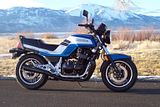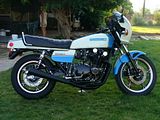Another write-up recommended VHT clearcoat... looks interesting.
Tired of continually polishing aluminum or pot metal?
- Polish the part (for the last time), spray on a coat of Clear VHT and allow to dry.
- Take the bike, or car, for a spin, and the engine heat will cure the coating!
- That's it! Finished - for good!
- Ideal for Use on:
- Automotive Exhaust
- Snowmobiles Jet Ski
- Motorcycle Exhaust & aluminum parts
- Barbecues Franklin Stoves Fireplaces Mufflers
Since its inception, new ideas for applications have been developed by numerous industrial, automotive, and electrical engineers. These include aerospace hardware, smoke stacks, jet engines, heat exchangers, boilers, heaters, exhaust manifolds, mufflers, steam pipes, barbecues, electrical hardware, and countless other applications where resistance to high temperatures and/or weathering is required.
Leading major industrial firms have come to rely on VHT FlameProof coating to solve many of their most difficult problems. Firms such as IBM, Corning glass, Colt Industries, B.F. Goodrich, Bechtol Corporation, Combustion Engineering, Air Research, Alcoa, RCA, Raytheon, NASA, Hughes Aircraft Lockheed, Cessna, North American Rockwell, and countless others equally impressive have benefited by VHT's progress in high temperature coatings.
Surface preparation:
- No special surface preparation is required, except removal of oil films, etc.
- Anodized, irridited and alodyned surfaces can be directly coated with VHT FlameProof for lower temperature use only.
Thin as necessary with a quality grade lacquer thinner available from local supplier. Do not thin more than 25% by volume.
Application:
Apply a THIN, even coat - just enough to thoroughly COLOR. Excessive build-up is not necessary or recommended. In applications requiring heavy coating, build-up should be done in stages, each successive coat being cured as recommended below nominal coating wet thickness .0015" - .002". VHT FlameProof coatings require no primer.
Curing:
On non-traffic surfaces and where solvent resistance is not required, VHT FlameProof coating may be used as is. Air-dried curing may be accomplished by the inherent heat of operation such as encountered in engine manifolds and exhausts, boilers, heaters, etc. or by following the curing instructions below. VHT FlameProof coatings will air dry in 15 to 30 minutes and, if handled with reasonable care, may be put to immediate use.
Heat curing method for maximum resistance to solvents, salt spray, humidity, thermal shock and heat:
In a dedicated electric oven:
- 15 minutes at 250°F
- 30 minutes at 600°F
- 1 hour at 800°F
- 30 minutes at 1,000°F.
.png)



Comment